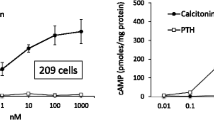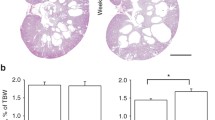Abstract
Polycystic kidney disease (PKD) is the most common life-threatening genetic disorder with bilateral cysts caused by increased level of cyclic adenosine 3′,5′-monophosphate (cAMP). Since adenylyl cyclases (ACs) catalyze cAMP formation, pharmacological characterization of renal AC isoforms is essential. Therefore, we analyzed differences in activation, inhibition, and regulation of AC isoforms in rabbit cortex and medulla membranes. Glucagon, [8-arginine]vasopressin (AVP) and catecholamines significantly activated cortical AC. However, in medulla only glucagon and AVP activated AC. Under Mg2+ conditions the profile of cortical membrane AC enzyme kinetics and the inhibitory profile of 2′(3′)-O-(N-methylanthraniloyl) (MANT) nucleotides resembled recombinant AC5. In contrast, the K i values of MANT nucleotides for medullary membrane AC and its kinetic properties were similar to those of recombinant AC1. Reverse-transcriptase PCR confirmed the presence of AC1 and AC5 in medulla and cortex, respectively. Cortical AC was sensitive to inhibition by Ca2+, corroborating the importance of AC5. However, Ca2+/CaM dependency specific for AC1 was not found in medulla. In conclusion, according to expression, kinetics and inhibition by MANT nucleotides both parts of the kidney differ in their AC isoforms. Whereas Ca2+-inhibitable AC5 was confirmed in renal cortex, the initially assumed AC1 activation in medulla could not be confirmed, pointing to the involvement of another AC isoform with some similarity to AC1. Since PKD is characterized by predominant involvement of the collecting duct and the distal nephrons located in renal cortex, AC5 may be the major AC isoform in this part of the kidney where cAMP increases cyst growth. Thus, potent and selective AC5 inhibitors could constitute a novel approach to treat PKD.










Similar content being viewed by others
Abbreviations
- AC:
-
Adenylyl cyclase
- cAMP:
-
Cyclic adenosine 3′,5′-monophosphate
- GPCR:
-
G-protein-coupled receptor
- IBMX:
-
3-isobutyl-1-methylxanthine
- MANT-NTP:
-
2′(3′)-O-(N-methylanthraniloyl)-nucleoside 5′-triphosphate
- MANT-NTPγS:
-
2′(3′)-O-(N-methylanthraniloyl)-nucleoside 5′-[γ-thio]triphosphate
- CaM:
-
Calmodulin
- FS:
-
Forskolin
- AVP:
-
[8-arginine]vasopressin
- GTPγS:
-
Guanosine 5′-[γ-thio]triphosphate
- PKD:
-
Polycystic kidney disease
- RT-PCR:
-
Reverse-transcription polymerase chain reaction
References
Barajas L, Liu L, Powers K (1992) Anatomy of the renal innervation: intrarenal aspects and ganglia of origin. Can J Physiol Pharmacol 70:735–749
Bek MJ, Zheng S, Xu J, Yamaguchi I, Asico LD, Sun XG, Jose PA (2001) Differential expression of adenylyl cyclases in the rat nephron. Kidney Int 60:890–899
Belibi FA, Edelstein CL (2010) Novel targets for the treatment of autosomal dominant polycystic kidney disease. Expert Opin Investig Drugs 19:315–328
Bradford MM (1976) A rapid and sensitive method for the quantitation of microgram quantities of protein utilizing the principle of protein-dye binding. Anal Biochem 72:248–254
Chabardés D, Imbert-Teboul M, Montegut M, Clique A, Morel F (1975) Catecholamine sensitive adenylate cyclase activity in different segments of the rabbit nephron. Pflüger’s Arch 361:9–15
Chabardés D, Firsov D, Aarab L, Clabecq A, Bellanger AC, Siaume-Perez S, Elalouf JM (1996) Localization of mRNAs encoding Ca2+-inhibitable adenylyl cyclases along the renal tubule. Functional consequences for regulation of the cAMP content. J Biol Chem 271:19264–19271
Cheng J, Grande JP (2007) Cyclic nucleotide phosphodiesterase (PDE) inhibitors: novel therapeutic agents for progressive renal disease. Exp Biol Med (Maywood) 232:38–51
Cooper DM (1994) Regulation of Ca2+-sensitive adenylyl cyclases by calcium ion in vitro and in vivo. Methods enzymol 238:71–81
Cooper DM (2003) Regulation and organization of adenylyl cyclases and cAMP. Biochem J 375:517–529
Cooper DM, Mons N, Fagan K (1994) Ca2+-sensitive adenylyl cyclases. Cell Signal 6:823–840
Defer N, Best-Belpomme M, Hanoune J (2000) Tissue specificity and pharmacological relevance of various isoforms of adenylyl cyclase. Am J Physiol Renal Physiol 279:F400–F416
Espinasse I, Iourgenko V, Defer N, Samson F, Hanoune J, Mercadier JJ (1995) Type V, but not type VI, adenylyl cyclase mRNA accumulates in the rat heart during ontogenic development. Correlation with increased global adenylyl cyclase activity. J Mol Cell Cardiol 27:1789–1795
Gallagher AR, Hidaka S, Gretz N, Witzgall R (2002) Molecular basis of autosomal-dominant polycystic kidney disease. Cell Mol Life Sci 59:682–693
Gao BN, Gilman AG (1991) Cloning and expression of a widely distributed (type IV) adenylyl cyclase. Proc Natl Acad Sci U S A 88:10178–10182
Gattone VH 2nd, Wang X, Harris PC, Torres VE (2003) Inhibition of renal cystic disease development and progression by a vasopressin V2 receptor antagonist. Nat Med 9:1323–1326
Gether U, Ballesteros JA, Seifert R, Sanders-Bush E, Weinstein H, Kobilka BK (1997) Structural instability of a constitutively active G-protein-coupled receptor. Agonist-independent activation due to conformational flexibility. J Biol Chem 272:2587–2590
Gille A, Lushington GH, Mou TC, Doughty MB, Johnson RA, Seifert R (2004) Differential inhibition of adenylyl cyclase isoforms and soluble guanylyl cyclase by purine and pyrimidine nucleotides. J Biol Chem 279:19955–19969
Göttle M, Geduhn J, König B, Gille A, Höcherl K, Seifert R (2009) Characterization of mouse heart adenylyl cyclase. J Pharmacol Exp Ther 329:1156–1165
Grantham JJ (1997) Polycystic kidney disease: huge kidneys, huge problems, huge progress. Trans Am Clin Climatol Assoc 108:165–170, discussion 170-172
Gretz N, Kränzlin B, Pey R, Schieren G, Bach J, Obermüller N, Ceccherini I, Klöting I, Rohmeiss P, Bachmann S, Hafner M (1996) Rat models of autosomal dominant polycystic kidney disease. Nephrol Dial Transplant 6:46–51, Suppl 11
Guillou JL, Nakata H, Cooper DM (1999) Inhibition by calcium of mammalian adenylyl cyclases. J Biol Chem 274:35539–35545
Hanaoka K, Guggino WB (2000) cAMP regulates cell proliferation and cyst formation in autosomal polycystic kidney disease cells. J Am Soc Nephrol 11:1179–1187
Heliés-Toussaint C, Aarab L, Gasc JM, Verbavatz JM, Chabardés D (2000) Cellular localization of type 5 and type 6 ACs in collecting duct and regulation of cAMP synthesis. Am J Physiol Renal Physiol 279:F185–F194
Houston C, Wenzel-Seifert K, Bürckstümmer T, Seifert R (2002) The human histamine H2-receptor couples more efficiently to Sf9 insect cell GS-proteins than to insect cell Gq-proteins: limitations of Sf9 cells for the analysis of receptor/Gq-protein coupling. J Neurochem 80:678–696
Hu B, Nakata H, Gu C, De Beer T, Cooper DM (2002) A critical interplay between Ca2+ inhibition and activation by Mg2+ of AC5 revealed by mutants and chimeric constructs. J Biol Chem 277:33139–33147
Kim KS, Kim J, Back SK, Im JY, Na HS, Han PL (2007) Markedly attenuated acute and chronic pain responses in mice lacking adenylyl cyclase-5. Genes Brain Behav 6:120–127
Lowry OH, Rosebrough NJ, Farr AL, Randall RJ (1951) Protein measurement with the Folin phenol reagent. J Biol Chem 193:265–275
Ludwig MG, Seuwen K (2002) Characterization of the human adenylyl cyclase gene family: cDNA, gene structure, and tissue distribution of the nine isoforms. J Recept Signal Transduct Res 22:79–110
Madsen P, Knudsen LB, Wiberg FC, Carr RD (1998) Discovery and structure-activity relationship of the first non-peptide competitive human glucagon receptor antagonists. J Med Chem 41:5150–5157
Mandon B, Siga E, Champigneulle A, Imbert-Teboul M, Elalouf JM (1995) Molecular analysis of β-adrenergic receptor subtypes in rat collecting duct: effects on cell cAMP and Ca2+ levels. Am J Physiol 268:F1070–F1080
Masada N, Ciruela A, Macdougall DA, Cooper DM (2009) Distinct mechanisms of regulation by Ca2+/calmodulin of type 1 and 8 adenylyl cyclases support their different physiological roles. J Biol Chem 284:4451–4463
Meister B, Dagerlind A, Nicholas AP, Hokfelt T (1994) Patterns of messenger RNA expression for adrenergic receptor subtypes in the rat kidney. J Pharmacol Exp Ther 268:1605–1611
Mou TC, Gille A, Fancy DA, Seifert R, Sprang SR (2005) Structural basis for the inhibition of mammalian membrane adenylyl cyclase by 2’(3’)-O-(N-methylanthraniloyl)-guanosine 5’-triphosphate. J Biol Chem 280:7253–7261
Ortíz-Capisano MC, Ortíz PA, Harding P, Garvin JL, Beierwaltes WH (2007) Decreased intracellular calcium stimulates renin release via calcium-inhibitable adenylyl cyclase. Hypertension 49:162–169
Patel TB, Du Z, Pierre S, Cartin L, Scholich K (2001) Molecular biological approaches to unravel adenylyl cyclase signaling and function. Gene 269:13–25
Pieroni JP, Harry A, Chen J, Jacobowitz O, Magnusson RP, Iyengar R (1995) Distinct characteristics of the basal activities of adenylyl cyclases 2 and 6. J Biol Chem 270:21368–21373
Pinto C, Papa D, Hübner M, Mou TC, Lushington GH, Seifert R (2008) Activation and inhibition of adenylyl cyclase isoforms by forskolin analogs. J Pharmacol Exp Ther 325:27–36
Premont RT, Chen J, Ma HW, Ponnapalli M, Iyengar R (1992) Two members of a widely expressed subfamily of hormone-stimulated adenylyl cyclase. Proc Natl Acad Sci U S A 89:9809–9813
Schneider EH, Schnell D, Papa D, Seifert R (2009) High constitutive activity and a G-protein-independent high-affinity state of the human histamine H4-receptor. Biochemistry 48:1424–1438
Schweda F, Friis U, Wagner C, Skott O, Kurtz A (2007) Renin release. Physiology (Bethesda) 22:310–319
Seifert R, Lee TW, Lam VT, Kobilka BK (1998) Reconstitution of β2-adrenoceptor-GTP-binding-protein interaction in Sf9 cells—high coupling efficiency in a β2-adrenoceptor-GSα fusion protein. Eur J Biochem 255:369–382
Shen T, Suzuki Y, Poyard M, Miyamoto N, Defer N, Hanoune J (1997) Expression of adenylyl cyclase mRNAs in the adult, in developing and in the Brattleboro rat kidney. Am J Physiol 273:C323–C330
Störk PJ, Schmitt JM (2002) Crosstalk between cAMP and MAP kinase signaling in the regulation of cell proliferation. Trends Cell Biol 12:258–266
Sunahara RK, Taussig R (2002) Isoforms of mammalian adenylyl cyclase: multiplicities of signaling. Mol Interv 2:168–184
Sweeney WE Jr, Avner ED (2006) Molecular and cellular pathophysiology of autosomal recessive polycystic kidney disease (ARPKD). Cell Tissue Res 326:671–685
Taha HM, Schmidt J, Göttle M, Suryanarayana S, Shen Y, Tang WJ, Gille A, Geduhn J, König B, Dove S, Seifert R (2009) Molecular analysis of the interaction of anthrax adenylyl cyclase toxin, edema factor, with 2′(3′)-O-(N-(methyl)anthraniloyl)-substituted purine and pyrimidine nucleotides. Mol Pharmacol 75:693–703
Takaichi K, Uchida S, Kurokawa K (1986) High Ca2+ inhibits AVP-dependent cAMP production in thick ascending limbs of Henle. Am J Physiol 250:F770–F776
Tang WJ, Krupinski J, Gilman AG (1991) Expression and characterization of calmodulin-activated (type I) adenylylcyclase. J Biol Chem 266:8595–8603
Tiniakos D, Anagnostou V, Stavrakis S, Karandrea D, Agapitos E, Kittas C (2004) Ontogeny of intrinsic innervation in the human kidney. Anat Embryol (Berl) 209:41–47
Tobise K, Ishikawa Y, Holmer SR, Im MJ, Newell JB, Yoshie H, Fujita M, Susannie EE, Homcy CJ (1994) Changes in type VI adenylyl cyclase isoform expression correlate with a decreased capacity for cAMP generation in the aging ventricle. Circ Res 74:596–603
Torres VE (2004) Cyclic AMP, at the hub of the cystic cycle. Kidney Int 66:1283–1285
Torres VE, Harris PC, Pirson Y (2007) Autosomal dominant polycystic kidney disease. Lancet 369:1287–1301
Vatner SF, Yan L, Ishikawa Y, Vatner DE, Sadoshima J (2009) Adenylyl cyclase type 5 disruption prolongs longevity and protects the heart against stress. Circ J 73:195–200
Wang X, Gattone V 2nd, Harris PC, Torres VE (2005) Effectiveness of vasopressin V2 receptor antagonists OPC-31260 and OPC-41061 on polycystic kidney disease development in the PCK rat. J Am Soc Nephrol 16:846–851
Xia Z, Choi EJ, Wang F, Blazynski C, Storm DR (1993) Type 1 calmodulin-sensitive adenylyl cyclase is neural specific. J Neurochem 60:305–311
Younes A, Lyashkov AE, Graham D, Sheydina A, Volkova MV, Mitsak M, Vinogradova TM, Lukyanenko YO, Li Y, Ruknudin AM, Böheler KR, van Eyk J, Lakatta EG (2008) Ca2+-stimulated basal adenylyl cyclase activity localization in membrane lipid microdomains of cardiac sinoatrial nodal pacemaker cells. J Biol Chem 283:14461–14468
Acknowledgments
The authors thank PD. Dr. K. Höcherl (Institute of Physiology, University of Regensburg, Regensburg, Germany) for his help with the AC primer selection. Thanks are also due to Mrs. Susanne Brüggemann and Mrs. Astrid Seefeld for expert technical assistance. Thanks are also due to the reviewers of this paper for their helpful critique. This work was supported by Deutsche Forschungsgemeinschaft [Grant Se 529/5-2] to R. S.
Author information
Authors and Affiliations
Corresponding author
Rights and permissions
About this article
Cite this article
Erdorf, M., Seifert, R. Pharmacological characterization of adenylyl cyclase isoforms in rabbit kidney membranes. Naunyn-Schmied Arch Pharmacol 383, 357–372 (2011). https://doi.org/10.1007/s00210-011-0600-7
Received:
Accepted:
Published:
Issue Date:
DOI: https://doi.org/10.1007/s00210-011-0600-7




